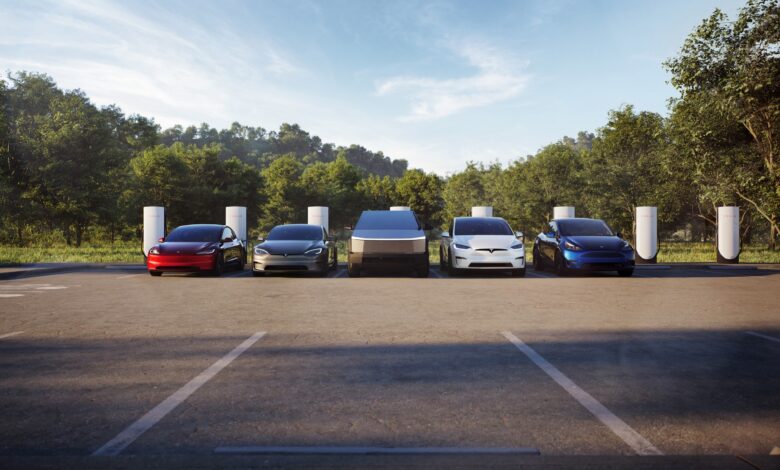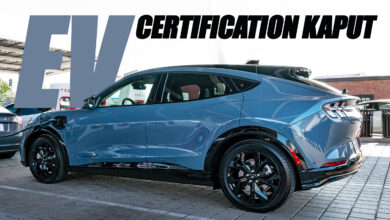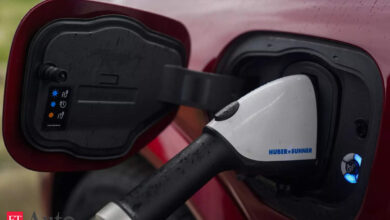5 Key Areas Where Tesla Is No Longer Leading (and One Where It Kills the Competition)

After an impressive 2023, Tesla started 2024 from a defensive position, retreating from key areas where it doesn’t see itself as the sector leader. These include manufacturing, mass-production EVs, and charging, considered critical to Tesla’s mission not long ago. To compensate, the EV maker pivoted toward autonomous driving and robotaxis, where it still sees itself as unbeatable.
Tesla defied all odds by going against everything the auto automotive industry had accomplished throughout the years. Instead of relying on suppliers and partners to develop the components for its vehicles, Tesla designed its own. The level of vertical integration at Tesla is unprecedented and almost impossible for legacy carmakers to replicate unless they are willing to start from scratch. Tesla designs and produces battery cells, drive units, electronics, audio systems, and even seats, and they are all top-class.
Tesla basically reinvented the car
Tesla also reinvented the way cars are produced by designing new production workflows and techniques. If we look at Gigafactory Shanghai, it’s the most advanced vehicle production facility in the world. This is not only because it has the biggest annual production capacity at 1 million units but also because it is the most efficient, allowing Tesla unprecedented economy-of-scale and cost benefits.
Tesla Giga Shanghai pioneered the concept of “warehouse on wheels,” which means that all parts used in the manufacturing process are offloaded directly on the production line at precise moments and locations. This negates the need for traditional warehouses and further increases manufacturing efficiency. So far, other car manufacturers have not implemented this concept, and Tesla is already working on a completely new manufacturing concept.
The megacastings and structural battery pack idea is another area in which Tesla has led the way. Even though other carmakers have tried to catch up by switching to megacastings, Tesla still has an important edge. Tesla has more advanced alloy technology and understands die-casting better than others. This allows it to use smaller die-casting machines for the same effect. The megacastings are also lighter while providing the same structural benefits.
Tesla went further and also reinvented distribution and after-sales. Instead of relying on outside partners and dealers, Tesla sells directly to consumers. It also services the vehicles through its own service centers. And finally, because electric cars needed to be charged and charging stations were sparse in the early years, Tesla created its own charging network, the Supercharger. It soon became the best and largest fast-charging network in the world.
Considering all these aspects, it doesn’t take a genius to understand why Tesla managed to become profitable while all others struggled to get there. Legacy carmakers have scaled back their EV ambitions because they lost insane amounts of money trying to compete with Tesla. For EV startups, things are even more difficult because they don’t have a profitable ICE business to fall back on.
However, things don’t always stay the same without continuous efforts, and Tesla entered rough waters in 2023. Maybe the economic conditions made people less willing to spend on electric vehicles. Maybe it was the geopolitical conditions that raised costs for Tesla. Or maybe Tesla’s vehicles are no longer what people want, or a combination of these factors. Whatever the case, Tesla is now on the defense in most sectors where it once excelled.
Manufacturing is no longer a priority for Tesla
Based on the actions taken over the past months, Tesla is no longer considering manufacturing to be a key area. The company doesn’t want to compete on volumes or price at a moment when Chinese carmakers are flooding the market with cheap electric vehicles. Although Tesla’s position in the US is still safe because there aren’t many Chinese EVs on the market, the situation is different in China and Europe.
The first sign of Tesla’s retreat from this area came after it started playing with the idea of an affordable model in recent years. The will they, won’t they game appeared to have ended at the Investor Day in March 2023, when Tesla unveiled the unboxed manufacturing process. However, Elon Musk changed his mind again in light of recent FSD advancements.
First, the new factory in Mexico where the affordable EV was supposed to be built was put on the back burner. Tesla delayed construction plans and later announced that the unboxed process would be developed at Giga Texas instead. The $25,000 Gen-3 EVs were also relocated to start production in Austin before expanding to another factory.
During this year’s first-quarter earnings call, Tesla announced that no new production sites will be developed, focusing on utilizing existing manufacturing capacity. It also confirmed what people have suspected: the mass-volume EV was no longer a priority. Instead, Tesla would produce a robotaxi using the Gen-3 architecture and the unboxed manufacturing process.
The work on the new architecture would not be completely lost, though. Tesla mentioned that it would integrate elements of the next-generation platform into existing models. It also hinted at new EV models built using a mix of Gen-2 and Gen-3 architectures but using the existing production lines and manufacturing processes. This promises to accelerate development but without the cost benefits of the unboxed process.
Tesla started using the megacastings with the Model Y and planned to transition from using front and rear castings attached to a structural battery to a single-piece gigacasting incorporating everything. Based on recent reports, this is no longer the case, and Tesla abandoned efforts in this crucial area.
To be fair, this idea would not have made sense with the unboxed vehicle process, which implies that the vehicle is split into separate sections. But then again, the unboxed process is no longer a priority, with only the robotaxi planned to use it in the future. It’s still early to tell where Tesla is heading in manufacturing, but it sure looks like this is not important anymore.
Battery development is stagnating
Tesla wowed everyone in 2021 during Battery Day when it announced the 4680 cells. These were not only larger cells but also better and cheaper to produce, thanks to new technologies like silicone anode and dry electrode manufacturing. However, when the first cells started production, they proved the opposite of what was promised. The 4680 cells were more expensive, slower charging, and had less energy density than the 2170 cells.
This is why the first car using them, the Model Y AWD produced at Giga Texas, had poor performance. Many people who bought one to experience Tesla’s latest battery technology were disappointed to see it perform worse in every way. Hopes that Tesla might improve the 4680 cell performance with a software update after gathering enough data quickly faded away, and Tesla discontinued the model when it started Cybertruck production.
The Cybertruck uses a more advanced type of the 4680 cells, dubbed “Cybercells,” but they are only marginally better than the first generation. This is the main reason why the electric pickup falls short of the promised range, which was 500 miles in the case of the tri-motor Cyberbeast. It still suffers from poor charging performance, which is one of the most common complaints from those who have bought a Cybertruck.
Tesla’s fixation on the 4680 cells made it lose ground on other battery technologies. It also forced it to import battery cells from China for its US-made vehicles. For this reason, the refreshed Model 3 RWD and Model 3 Long Range don’t qualify for the federal tax credit, making them a tough sell.
At the same time, Tesla is threading water while Chinese battery manufacturers are full steam ahead, pushing the envelope of what lithium-iron-phosphate (LFP) chemistry can offer. The latest generations of LFP cells from BYD and CATL are closer in energy density to Tesla’s 4680 cells and provide extremely fast charging rates even in cold temperatures. They are also cheaper and more durable, so Tesla may have bet on a dead horse.
After former SVP of Powertrain and Energy Engineering Drew Baglino left the company, Tesla named Bonne Eggleston as the new head of the 4680 battery program. He aims to make the 4680 cells cheaper to manufacture than comparable batteries from suppliers like Panasonic and LG Energy Solution. However, his mission might be harder than anticipated. Tesla reportedly laid off 20% of the battery team and is considering scrapping it altogether if the reorganization doesn’t yield the desired cost savings by the end of the year.
This is not even inconceivable after Musk fired the entire Supercharger team, including its chief, Rebecca Tinucci. The disbanding of the Supercharger team marked a surprising move, considering that it was an important revenue center and one of the most promising Tesla divisions. Elon Musk confirmed that new Supercharger deployments will slow, while rumors indicate that Tesla might sell off its charging infrastructure division.
Tesla is losing ground in efficiency and range
When Tesla started the EV revolution, electric vehicles were nothing more than experimental contraptions without much practical use. The Nissan Leaf started sales in 2010 as the first mass-produced electric vehicle, but could only travel 73 miles on a charge. The Tesla Roadster, which preceded it by two years, had a 244-mile range. However, at $100K, it was hardly a sales hit, with only 2,450 units sold in its entire life. This allowed Nissan to claim the title of the world’s best-selling EV.
Tesla maintained a healthy lead in battery technology and range with the Model S, which could travel up to 265 miles on a charge when it launched in 2012. The Model S is still Tesla’s longest-range model today, with an EPA estimate of 405 miles for the base model. However, this is no longer enough to secure the longest-range EV title. Instead, Lucid claimed it with the Air sedan. The Grand Touring variant has an EPA range of 516 miles, but all other variants offer a better range than Tesla’s longest-range model.
This is not the only market segment where Tesla lags behind competition. Tesla loses the range battle in all segments, with all its models offering a lower range than their competitors. The Cybertruck and the Model Y have the fiercest competition, each being surpassed by four competing EVs in their category. It’s no wonder, considering these are the most crowded market segments in the US.
When Lucid certified the Air sedan for 520 miles of EPA range, Elon Musk reacted by saying that a longer range equals a bigger battery and thus more weight, which affects efficiency. Musk considered that people would not need more than 300 miles of range, and that’s what most Tesla models still offer. Tesla’s EVS are indeed among the most efficient vehicles on the market, but they are no longer the best, even in this regard.
From the beginning, Lucid aimed for a 5-mile (8 km) per kWh energy efficiency, compared to an industry average of 3 miles (5 km) per kWh. In the Q1 2024 shareholder deck, Lucid showed that Air Pure RWD, its most affordable model, achieved 4.74 mi/kWh, very close to the targeted efficiency. Other Lucid Air variants are not far behind, whereas the Tesla Model S ranks only fourth, with 3.89 miles per kWh.
Bild quality is not consistent with Tesla’s luxury vehicle status
Tesla has been considered a luxury carmaker based on the price and features offered on the OG Model S. However, in the 12 years that passed, the car industry moved to an “everything plus the kitchen sink” approach in the luxury segment. People buying a Tesla today don’t do it because they want a luxury or electric vehicle. They do it because they want a Tesla.
And this is knowing well that they don’t get the best build quality available. Tesla owners often complain about quality issues, including rattling dashboards, misaligned body panels, and tearing or peeling parts. Although rare, missing parts, including fasteners, have also been reported by some owners. This led to steering wheels falling off and underbody protection panels detaching when driving through a puddle.
Tesla has solved many quality issues that have become common in US-made vehicles. However, the Cybertruck, its latest model, still suffers from teething problems. Owners complained about software issues, broken steering actuators, missing fasteners that led to detaching parts, and loose lug nuts that can cause the wheels to fall off. This aligns well with the “deliver now, fix later” policy that affected many early vehicles of a new Tesla model.
However disappointing it is to have a new car that rattles and loses parts, Tesla EVs disappoint in other areas, too. Many have complained that Tesla lags behind the competition when it comes to luxury features. It’s 2024, and you still can’t order massaging seats on a flagship Tesla Model S or Model X. The materials in the cabin are also pretty basic, considering the luxury claims. Tesla has been trying to correct this with the refreshed Model 3, which has better materials and more comfort features. However, it needs to do more to keep customers interested.
This is especially true in China, where people demand luxurious interiors with high-quality materials. However, Tesla continues to sell the same basic interiors across the Model Y and Model 3, and this is starting to cost it. Xiaomi has just begun delivering its first electric vehicle, the SU7, which already surpassed the Tesla Model 3 in April. According to registration data from China, Xiaomi delivered 7,058 units of the SU7 sedan, whereas Tesla only moved 5,065 units of the Model 3.
Many argue that Tesla compensates in other areas, where it’s far ahead of the competition, but that shouldn’t be an excuse. Tesla EVs used to have the most advanced battery and drivetrain technologies, but others have caught up in these areas. Competition is heating up, and Tesla needs to step up if it still wants to continue selling cars. However, considering the latest developments, this might not even be the case.
Tesla’s strength is in software and Full Self-Driving
If there’s one thing that people unanimously appreciate at Tesla is the software. The pioneer of over-the-air updates also offers the best software experience in the automotive world. Most people consider Tesla software so good that they don’t even complain about the lack of Apple CarPlay or Android Auto support. This is a constant cause of disappointment with Rivian EVs, and Rivian is no slouch in the software department either.
However, the best software Tesla has developed is not the infotainment system but its driver assistance systems. Autopilot and Full Self Driving are considered the best in the industry, with the latter progressing fast toward earning its name. With the latest builds of FSD V12, Tesla proved that vision-only autonomous driving is possible. Owners who tried FSD V12.3.6 report driving for hundreds of miles with zero disengagements, which is pretty close to autonomous driving.
FSD software has become so good that Elon Musk wants to bet the company’s future on it. This is the primary reason Tesla is not going forward with its plans for a high-volume electric car. Musk is confident (wasn’t he always?) that Tesla could achieve vehicle autonomy in a short time, rendering vehicle manufacturing superfluous. This would open an almost infinite revenue stream for Tesla, dwarfing everything else.
Tesla is facing a conundrum here, as the world would not need as many autonomous vehicles as it needs passenger vehicles now. This means it will have fewer customers and thus produce fewer vehicles because they will drive almost continuously (except when they charge). On the other hand, if Tesla cracks self-driving, Tesla would have no reason to sell its autonomous vehicles. Instead, it will monetize them itself, creating almost infinite wealth.
This is an area where Tesla is obviously ahead of the competition. One year ago, Musk said you need a telescope to even see the competition, and he wasn’t exaggerating. Many autonomous driving startups have bitten the dust, and few still standing follow the vision-only, end-to-end AI recipe Tesla pioneered. Even Chinese companies, which had a head start in China, rely on Lidar sensors and high-definition maps, which makes them perform poorly in situations where reality doesn’t look like the map.
We see how good such systems are with the Mercedes-Benz Drive Pilot, certified as a Level-3 autonomous driving system. The system only works on pre-mapped highways in California and Nevada and has so many limitations that it’s difficult to even see it working. You must be in a traffic jam on a highway traveling less than 40 mph and have a vehicle in front to follow. The road also must have clear lane markings, and the weather must be perfect. And, God forbid you need it at night because it won’t work.



